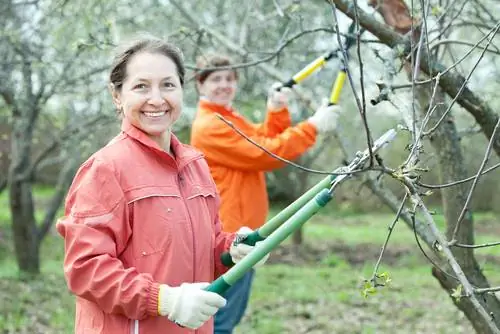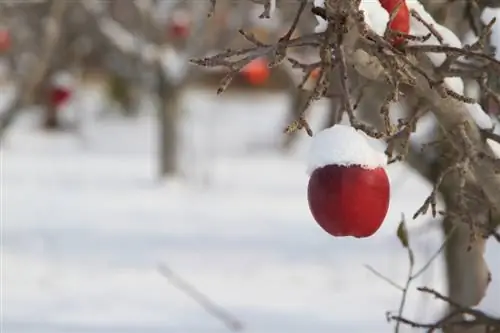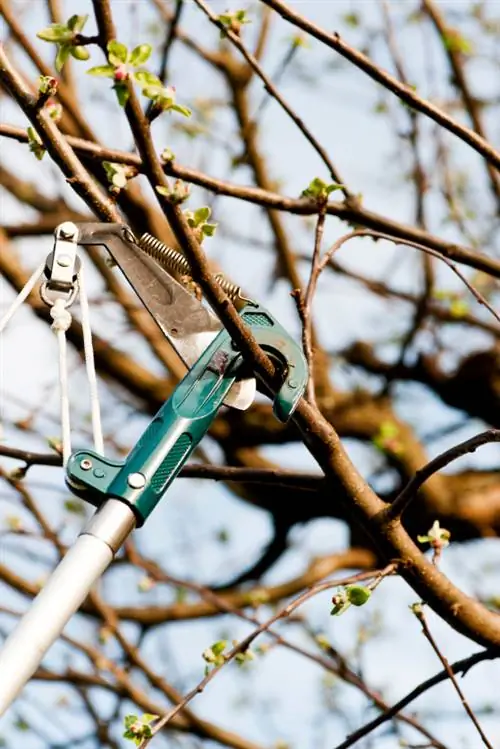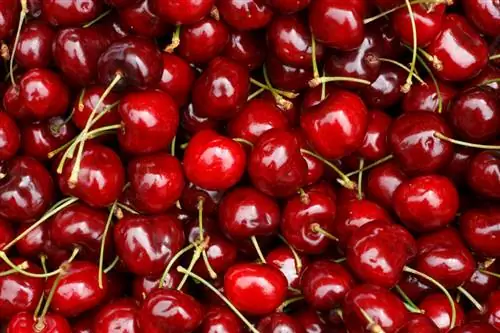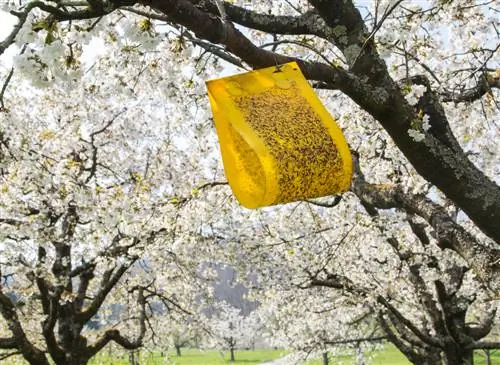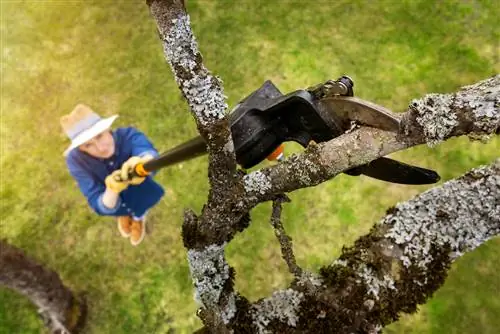- Author admin [email protected].
- Public 2023-12-26 14:17.
- Last modified 2025-06-01 06:02.
When caring for fruit trees, gardeners differentiate between winter and summer pruning. Regular pruning guarantees lavish blossoms and lots of juicy fruits. The timing is just as important as the incision. This tutorial is full of well-founded instructions on when and how to prune fruit trees in an exemplary manner.

When and how should you prune fruit trees?
Pruning fruit trees correctly promotes their he alth and fertility. Pome fruits such as apples and pears should be pruned every 2-5 years in late winter (February), while stone fruits such as cherries and plums need pruning every 1-2 years in the summer or fall after harvest.
Pome fruit and stone fruit - cutting types and dates
For the perfect cut onpome fruit treesan appointment inlate winterhas been established. In February there is a lot of activity in the apple, pear and quince crowns when gardeners devote themselves to the worn and future fruit wood. Well-behaved pome fruit copes well with pruning every 2 to 5 years. Stone fruitresponds better to aSummer cut, either in connection with the harvest or after the leaves have fallen in autumn. No rule without exception also applies to pruning fruit trees, such as cherries. The following table summarizes important types of cuts and recommended dates:
| Cut style | Goal/Occasion | best date |
|---|---|---|
| Pome fruit conservation cut | Promoting the fertility of pome fruit | every 2 to 5 years in February |
| Stone fruit conservation cut | Maintain vitality, he alth and profitability | every 1 to 2 years in summer or autumn after harvest |
| Special case: sweet cherry | promote new fruit wood | every 4 to 5 years in the summer after harvest |
If a fruit tree pruning goes far beyond care and preservation, the Federal Nature Conservation Act has the say when choosing the date. To protect our massively threatened birdlife, radical tree pruning isprohibited from March 1st to September 30thRestrained pruning measures may be carried out during the grace period as long as there are no bird nests in the branches.
Cut pome fruit in February
The main task of a maintenance pruning is to promote fertility and fruit quality. A crown flooded with light is just as important as young side shoots withoblique-horizontal orientation The best apples, pears and quinces are harvested from sun-drenched fruit branches that are a maximum of half as thick as the main shoot. As the illustration below illustrates, all wood that affects scaffolding shoots and fruit wood must now go. How to cut correctly:
- Remove all shoots competing with the central shoot and leading branches
- Tear off or cut off vertical shoots on the tops of the branches (water shoots)
- Cut out dead, weak, damaged branches that are directed towards the inside of the crown
- Cut back too long, heavily branched scaffold shoots to an outward-facing bud
In the last step you will devote yourself to the most precious treasure of a fruit tree crown, the fruit wood. The sweet burden of past years has left its mark. Exhausted fruit shoots can be easily recognized by their low, drooping growth. Select a vital side shoot behind the apex to cut off the worn, outdated wood at this point. The proven pruning technique serves as local rejuvenation and is known in gardening circles as derivation pruning.
You have done everything right if your pome fruit tree presents itself with alight crown. Ideally, according to the tried and tested gardening rule, you can “throw a hat through a cut apple tree and catch it again”. You don't have to take the wisdom literally, although it contains a kernel of truth. An airy crown results in minimal susceptibility to fungal infections and allows larger, juicier fruit to ripen.
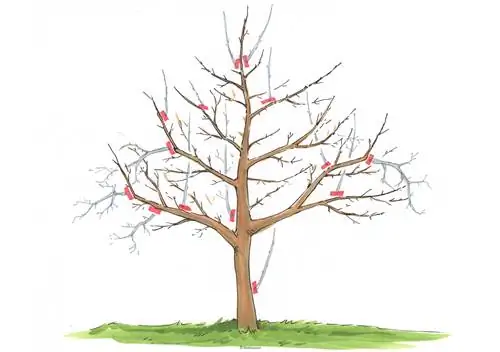
After 2 to 5 years, the fruit wood in pome fruit has been exhausted. With a comprehensive maintenance pruning you clear the way for young fruit shoots. Dead wood, waterlogs and unfavorable branches are removed. Worn, low-hanging fruit wood is rejuvenated by directing it to a side shoot further in.
Tip
Older pome fruit benefits from additional pruning in July. Cut off all steep shoots and leaves that cast shadows on apples, pears or quinces. Remove wild shoots. If there are too many fruit plants on the branches, thin out the fruits. Break down damaged or puny specimens. The most promising fruits should be at least 3 centimeters apart to ripen in premium quality.
Cutting stone fruit in summer
Traditionally, stone fruit is cut in summer because the wood is more susceptible to disease and rot. If a fruit tree is full of sap, it can close cuts more quickly and ward off pathogens better. You can cut plums, plums and sour cherries either at the same time as the harvest or after the leaves have fallen in autumn. Although the cutting method does not differ significantly from pome fruit, the following aspects should be taken into account when cutting stone fruit:
- When cutting in summer, shoots with round-shaped flower budsdon'tintersect
- Drooping, old fruit wood derived from a two-year-old side shootgarnished with flower buds
- If fruit wood is too thick (almost as thick as the leading branch), cut it back to 10 to 20 cm long cones
- Short unfavorable, dead branches to 5 cm short stubs
- This year's unbranched long shoots withmore than 20 cm long shorten by a third
On some of the most popular sour cherries, it is primarily the annual shoots that bloom and bear fruit. Shadow Morelleand varieties resulting from it should be cutevery year for this reason. The aim of the cut is to ensure that there are no more than three annual shoots with a length of 20 to 30 centimeters for every 10 centimeters of leading branch length. After harvesting, cut back branches vigorously to two buds or an inner side shoot. Fresh fruity shoots sprout from this in the same year, which bloom the next spring and then bear fruit.
Background
note juice scale
One of the most important premises when pruning fruit trees is observing the juice scale. The classic fruit tree crown is pyramidal in shape with a continuous, dominant central shoot and three to four lateral leading branches. Uniform growth is only ensured if the tips of the leading branches are at the same height. The central shoot towers over its leading branches by 15 to 20 centimeters, so that an imaginary angle of 90° to 120° is formed. The illustration below shows, using the example of training an apple tree, how the crown structure should ideally be built and maintained.
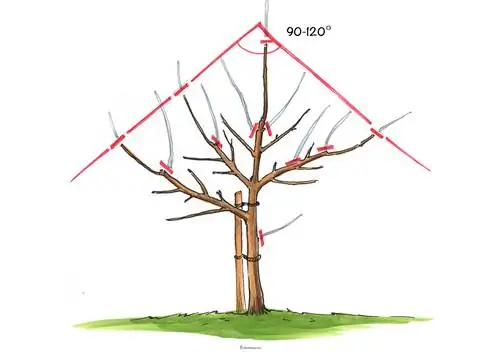
Treat a fruit tree with a pyramidal crown made of central shoots and three to four leading branches. Together, the framework forms an angle of 90° to 120°. The leading branches are in sap scale.
Cutting sweet cherries rarely
When the fruit wood on pome fruit or sour cherries has long since been exhausted, the sweet cherry still shines with lavish flowers and juicy fruits. A cut on the cherry tree is therefore a rarity. However, you should not completely eliminate pruning care. At intervals of four to five years, sweet cherries benefit from thinning out dead wood and rejuvenating fruit wood. How to do it right:
- The best time to cut is in summer, immediately after the harvest
- Tighten out unfavorably growing, dead and bare shoots
- Drooping branches with a diameter of more than 5 cm indicate a he althy side shoot
- Remove thick, old branches on cones that are 10 to 20 cm long
The most valuable asset of a sweet cherry isshort shoots, richly garnished with thickflower buds In gardening terms, the productive fruit wood is called a bouquet shoot and remains of spared the scissors. Otherwise there is nothing that speaks against courageous pruning in the cherry tree crown. A competent maintenance cut leaves an almost empty crown. That's nothing to worry about. On the contrary, the pruning effort is rewarded with a lushly flowering and richly bearing sweet cherry in the following years, until the next time maintenance pruning is on the care program.
Excursus
Steep shoots do not bear fruit
A tightly upright shoot grows vigorously upwards because the growth law of top promotion is at work here. In return, the massive height growth reduces fertility. Only in an inclined to horizontal position does the sap pressure decrease so that flowers can form. This does not mean that every steep shoot has to give way. If it is in an advantageous position in the crown structure, tie the shoot down, weigh it down with weights or regulate the direction of growth with spreading sticks.
Frequently asked questions
Why should fruit trees be cut? Can't I just let apples, pears or cherries grow?
The most important goal of pruning fruit trees is to promote fruit wood. It is important to keep those shoots that bear flowers and fruit vital and sun-kissed. The majority of fruit trees produce their flowers the previous year. The best fruiting wood on peaches or sour cherries is on annual branches. Apples and pears also bear fruit on two- and three-year-old shoots. Without regular pruning, a fruit tree crown will be outdated after four to five years at the latest and no longer bear any significant fruit.
I'm currently creating a natural garden with three to four fruit trees. I would like to care for these trees in harmony with nature and cut them as little as possible. How can this be achieved without foregoing a rich harvest?
Fruit trees develop a picturesque and natural habit if they are pruned little in the first few years. Minor interventions do not disrupt growth, but rather have a beneficial effect on a light-flooded crown shape with numerous flowers and fruits. Planting and training are completely in harmony with nature. In later years, every cut on fruit trees is a balancing act between optimizing the harvest and damaging the wood. If you plan the location for a fruit tree, it should be generous enough so that the crown can develop freely without the need for pruning to reduce its size. Thanks to this foresight, pruning care is reduced to an occasional fruit pruning on the apple or cherry tree every three to five years.
Are all fruit trees self-fertile?
Most types of fruit are not self-fertile. They only bear juicy fruit when another variety contributes its genetic information in the form of pollen. Modern varieties are sometimes declared to be self-fertile, which leads to disappointment among gardeners about poor harvest yields. When planting fruit trees, it has proven useful in gardening practice to plant at least two varieties in close proximity that cross-fertilize each other.
Is it true that you shouldn't cut fruit trees when it's frosty?
It turns out to be a misconception that pruning during frost causes damage to fruit trees. Thanks to intensive field tests by experienced experts, we now know that tree pruning down to -5 degrees Celsius is easily possible. Only when the thermometer drops lower should you approach a cut with caution. There is a great risk that shoots will tear or break off because the cold wood is brittle.
Which types of saws and scissors are recommended for cutting fruit trees?
Two types of saws are perfect for tree pruning: handy folding saws (€22.00 on Amazon) and flexible hacksaws with an adjustable saw blade. Folding saws, also known as Japanese saws, can cut hard-to-reach branches using pull. Hacksaws score points with their precise cutting on Astring because the saw blade can be individually adjusted. Among the scissors, two types are also vying for the gardener's favor. Bypass scissors work with two sharp blades that run past each other. Anvil scissors work with a straight, sharp cutting edge that is pressed onto a blunt counterpart. The bypass mechanism is convincing for cutting on living wood. The anvil mechanism has proven itself for cutting hard, dry branches.
The 3 most common cutting mistakes
If a fruit tree refuses the longed-for blossoms and juicy fruits, the gardener has made a pruning mistake. So that you can arm yourself against typical damage to fruit trees, the following table names three cardinal errors and gives tips for prevention:
| Cutting errors | malicious image | Prevention |
|---|---|---|
| never cut | premature aging, poor harvest yield | cut at least every 3 to 4 years |
| crown branches that are too steep | densely branched crown without valuable fruit wood | Leading branches form an ideal angle of 45° to 90° to the trunk |
| thick branches not cut off to astring or cones | Spread of wood rot | Saw off more than arm-thick branches in front of the astring or with 10 cm tenons |
A common faux pas is made by gardeners before the first cut is made. We're talking about unclean blades and saw blades. Statistical surveys have proven that the most common cause of diseases and pests on fruit trees can be traced back to contaminated cutting tools. Pathogenic pathogens use the cutting edges as a means of transport directly into the conductive pathways of the pruned shoots. Please do not neglect to clean and meticulously disinfect the tool before each cutting.

Tip
The perfect fruit tree pruning comes to nothing if there is a lack of hard-working insects as pollinators. In order to attract bees, bumblebees, hoverflies and other beneficial insects, the garden should be designed to be inviting. Early flowering bushes, such as the cornelian cherry, provide plenty of food. Insect hotels and flower pots filled with wood shavings invite you to linger and take care of the brood. Leave rotten tree trunks and piles of leaves lying around as desirable places to retreat. Of course, toxic pesticides and artificial fertilizers are frowned upon in the insect-friendly garden.

